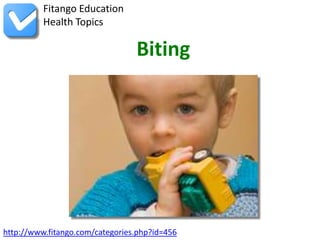
Biting
- 1. Fitango Education Health Topics Biting http://www.fitango.com/categories.php?id=456
- 2. Overview Biting is quite common in kids toddler age, but that's little consolation if your toddler bites. After all, no one wants their child to be considered the menace of the play group. And worse yet, kids who are labeled "biters" often get excluded from childcare centers — a challenge that no working parent wants to face. 1
- 3. Overview You may think biting is just another phase you'll have to live through, but that's not necessarily the case. There are ways to get to the bottom of your toddler's biting habit. 2
- 4. Why Toddlers Bite Believe it or not, biting is a normal part of early childhood development. Babies and toddlers bite for a variety of reasons, such as teething or exploring a new toy or object with their mouth ("mouthing"). As they begin to understand cause- and-effect, they also might bite a person to see if they can get a reaction. 3
- 5. Why Toddlers Bite Biting also can be a way for toddlers to get attention or express how they're feeling. Frustration, anger, and fear are strong emotions and toddlers lack the language skills to deal with them. So if they can't find the words they need quickly enough or can't articulate how they're feeling, they may resort to biting as a way of saying, "Pay attention to me!" or "I don't like that!" 4
- 6. Why Toddlers Bite Biting is slightly more common in boys and tends to occur most often between the first and second birthday. As language skills develop, so do coping skills and biting tends to lessen. For more information, read Why Toddlers Bite. 5
- 7. How To Curb Biting With biting, it's important to address the behavior immediately after it happens. The next time your child bites another child, separate the kids involved and try these steps: -- Step 1: **Comfort the victim first** 6
- 8. How To Curb Biting Direct your attention to the person who has been bitten, especially if it's another child. Addressing the wrong-doer first may reinforce this negative behavior if he or she bites to get attention. If there is an injury, clean the area with soap and water and apply ice. -- Step 2:** Be calm and firm** 7
- 9. How To Curb Biting Address your child with a firm, "no biting!" or "biting hurts!" Keep it simple and easy for a toddler to understand. Make it clear that biting is wrong, but avoid lengthy explanations until your child is old enough to understand. Remaining as calm as possible will help to resolve the situation more quickly. -- Step 3: **Comfort the biter, if need be** 8
- 10. How To Curb Biting Oftentimes, toddlers may not realize that biting hurts. It's OK to comfort a child who may be feeling upset about hurting a friend. -- Step 4: **Offer alternatives** When things have calmed down, suggest alternatives to biting, like using the words "no," "stop," and "that's mine" when wanting to communicate with others. 9
- 11. How To Curb Biting -- Step 5: **Redirect. ** Distraction works wonders with kids this age. If emotions and energy levels are running high or if boredom has set in, help redirect a little one's attention to a more positive activity, like dancing to music, coloring, or playing a game. 10
- 12. How To Curb Biting Punishment is usually not necessary at this age, since biting is normal and most kids don't realize that their actions can cause harm to others. If, on the other hand, you've tried the steps above and the behavior doesn't stop, timeouts may be effective. Older toddlers (2-3) may be taken to a designated timeout area — a kitchen chair or bottom stair — for a minute or two to calm down. 11
- 13. How To Curb Biting As a general rule, about 1 minute per year of age is a good guide for timeouts. Shorter timeouts can be effective, but longer ones have no added benefit and can sometimes undermine your efforts if your little one gets up (and refuses to return) before you signal that the timeout has ended. 12